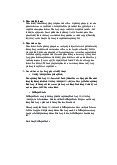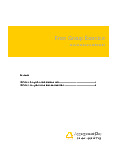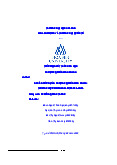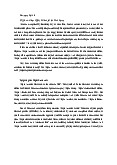





Preview text:
CHAPTER 10 • MEASURING SOURCES OF BRAND EqUITY: CAPTURING CUSTOMER MIND-SET 361 BRAND FOCUS 10.0
Young & Rubicam’s Brand Asset Valuator
This appendix summarizes the Brand Asset® Valuator (BAV), has been collected quarterly from an 18,000-person panel, which
originally developed by Young & Rubicam, now overseen and
enables the identification and analysis of short-term branding
expanded by The BAV Group.60 It is the world’s largest database trends and phenomena.
of consumer-derived information on brands. The BAV model is
developmental in that it explains how brands grow, how they get Four Pillars
into trouble, and how they recover.
There are four key components of brand health in BAV (see Figure
The BAV measures brands on four fundamental measures
10-14), referred to as “Brand Pillars.” Each pillar is derived from
of brand equity plus a broad array of perceptual dimensions.*
various measures that relate to different aspects of consumers’
It provides comparative measures of the equity value of thou-
brand perceptions. Taken together, the four pillars trace the pro-
sands of brands across hundreds of different categories, as
gression of a brand’s development.
well as a set of strategic brand management tools for plan-
ning: brand positioning, brand extensions, joint branding
• Energized Differentiation measures the degree to which
ventures, and other strategies designed to assess and direct
a brand is seen as different from others, and captures the
brands and their growth. The BAV is also linked to financial
brand’s direction and momentum. This is a necessary condition
metrics and is used to determine a brand’s contribution to a
for profitable brand building. It relates to pricing power and company’s valuation.
is often the key brand pillar in explaining valuation multiples
Since 1993, the BAV has researched nearly 1,200,000 consumers like market value to sales.
in 52 countries, enabling BAV to identify truly global brand trends.
• Relevance measures the appropriateness of the brand to con-
Consumers’ perceptions of approximately 56,000 brands have been
sumers and the overall size of a brand’s potential franchise or
collected across the same set of 75 dimensions, including 48 image penetration.
attributes, usage, consideration, and cultural and customer values.
• Esteem measures how wel the brand is regarded and respected—
These elements are incorporated into a specially developed set of
in short, how well it’s liked. Esteem is related to loyalty. brand loyalty measures.
The BAV represents a unique brand equity research tool.
• Knowledge measures how intimately familiar consumers
Unlike most conventional brand image surveys that adhere to a
are with a brand and is related to the saliency of the brand.
narrowly defined product category, respondents evaluate brands in
Interestingly, high knowledge is inversely related to a brand’s
a category-agnostic context. Brands are percentile ranked against potential.
all brands in the study for each brand metric. Thus, by comparing
Relationship Among the Pillars
brands across as well as within categories, the BAV can draw the
broadest possible conclusions about how consumer-level brand
Examining the relationships between these four dimensions—a
equity is created and built—or lost. In the United States, data
brand’s “pillar patterns”—reveals much about a brand’s current
B R A N D E Q U I T Y P I L L A R S
BR A N D S T R E N G T H BR A N D S TAT U R E Future Growth Potential Current Operating Value ENERGIZED DIFFERENTIATION RELEVANCE ESTEEM KNOWLEDGE Unique Meaning Appropriateness Regard Understanding
Relates to margins, loyalty, cultural currency
Relates to market penetration
Relates to perception of quality & respect Relates to consumer experience FIGURE 10-14
Four Pillars Assess Brand Health, Development, and Momentum
* In Chapter 11, we discuss five BAV dimensions, with energy being listed as a separate dimension. Young and Rubicam has combined
energy and differentiation dimensions and now call it energized differentiation. 362
PART IV • MEASURING AND INTERPRETING BRAND PERFORMANCE UNREALIZED POTENTIAL COMMODITY BRAND CULTURAL ICON The brand has captured
Price or convenience is the
Brand has the full potential
attention for its uniqueness. dominant reason to buy.
to realize its momentum. Examples: Examples: Examples: E_DIF REL TRADER Kashi TYLENOL Hanes BAND-AID Airbnb E_DIF REL E_DIF REL Apple Google JOE’S DESIRE TO FIND OUT MORE
LOOKING FOR BETTER OPTIONS CREDIBLE LEADERS
Brand is recognized for its
Brand is better liked than known.
Brand is better known than liked. leadership. Examples: Examples: Examples: EST KNO TESLA Calphalon EST KNO SPAM EXXON Bank of America EST KNO Coca-Cola Walmart Method FIGURE 10-15
Pillar Patterns Tell a Story
Source: BrandAsset Consulting. Used with permission.
and future status (see Figure 10-15). It is not enough to look at
Brands generally begin their life in the lower left quadrant,
each brand pillar in isolation; it is the relationships between the
where they first need to develop Relevant Differentiation and
pillars that tell a story about brand health and opportunities. Here
establish their reason for being. Some brands get “stuck” in this are some key relationships:
quadrant because of their commodity image or specialized mar-
keting, like Lincoln Financial and Marvin Windows. Most often,
• When Energized Differentiation is greater than Relevance, the
the movement from there is “up” into the top left quadrant.
brand is standing out and receiving attention in the market-
Increased Differentiation, followed by Relevance, initiates growth
place. It now has the potential to channel this point of differ-
in Brand Strength. These developments occur before the brand
ence and energy into building meaningfulness for consumers
has acquired significant Esteem or is widely known. by driving Relevance.
This quadrant represents two types of brands. For brands des-
• But if a brand is more Relevant than Differentiated, this suggests
tined for a mass target, like Method, illy, and Apple Pay, this is
commoditization. While the brand is appropriate and meaning-
the stage of emerging potential. Specialized or narrowly targeted
ful within the lives of consumers, it is perceived as interchange-
brands, however, tend to remain in this quadrant (when viewed
able with other players in the category. Therefore, consumers
from the perspective of a mass audience) and can use their strength
will not go out of their way for this brand, remain loyal to it, or
to occupy a profitable niche. This includes brands like Square,
pay a premium for it, since it lacks that special something we
Kimpton, and Snapchat. From the point of view of brand leaders,
quantify as Energized Differentiation. Convenience, habit, and
new potential competitors will emerge from this quadrant.
price become drivers of brand choice in this scenario.
The upper right quadrant, the Leadership Quadrant, is popu-
• Leadership brands are strong on both pillars, resulting in con-
lated by brand leaders—those that have high levels of both Brand
sumer passion as well as market penetration.
Strength and Brand Stature. Both older and relatively new brands
can be in this quadrant, meaning that brand leadership is truly a
Brands often strive to build awareness, but if the brand’s pil-
function of the pillar measures, not of longevity. When properly
lars are not in the proper alignment, then consumer knowledge
managed, a brand can build and maintain a leadership position
of a brand becomes an obstacle that may need to be surmounted
indefinitely. Examples of brands in the leadership position include
before the brand can continue to build healthy momentum. Apple, the NFL, and Disney.
• When a brand’s Esteem is greater than its Knowledge, con-
Although declining brand equity is not inevitable, brands for
sumers like what they know about the brand so far, and typi-
whom strength has declined (usually driven by declining Ener-
cally want to find out more, suggesting growth potential.
gized Differentiation) can also be seen in this same quadrant.
• However, if a brand’s Knowledge is greater than its Esteem, then
Brands whose Strength has started to dip below the level of their
consumers may feel that they know more than enough about
Stature display the first signs of weakness, which may well be
the brand, and they are not interested in getting to know it any
masked by their still-buoyant sales and wide penetration. Exam-
better. In this case, Knowledge is an impediment that the brand
ples include such brands as Macy’s, V8, and Visa.
must try to overcome if it wishes to attract more consumers.
Brands that fail to maintain their Brand Strength—their Rel-
evant Differentiation—begin to fade and move “down” into the
bottom right quadrant. These brands become vulnerable not just The PowerGrid
to existing competitors, but also to the depredations of discount
The Brand Asset® Valuator has integrated the two macro dimen-
price brands, and they frequently end up being drawn into heavy
sions of Brand Strength (Energized Differentiation and Relevance)
and continuous price promotion in order to defend their con-
and Brand Stature (Esteem and Knowledge) into a visual analyti-
sumer franchise and market share: American Airlines, Citibank,
cal representation known as the PowerGrid (see Figure 10-16).
ExxonMobil, and Kmart fall into this category.
The PowerGrid depicts the stages in the cycle of brand
A PowerGrid can also be used to measure a brand’s equity
development—each with its characteristic pillar patterns—in
among different constituencies. Figure 10-17 depicts The Wall successive quadrants.
Street Journal’s brand equity among various usage or demographic
CHAPTER 10 • MEASURING SOURCES OF BRAND EqUITY: CAPTURING CUSTOMER MIND-SET 363 facebook 100 Leadership Google Niche Apple NIKE yelp amazonkindle D_E R E K Cocla-Cola e IKEA HBO anc ev baskin macys el UNDER ARMOUR BRrobbins R D_E R E K d lululemon th an W VISA g n athletica HOTELS PUMA ren io method D_E R E K detox your home St tiat 50 d en Mass Market ran B iffer The Athlete’s HUNGRY-MAN D Foot Shell BLOCKBUSTER ized g er AmericanAirlines Time Out Spint En New York TV GUIDE D_E R E K D_E R E K Citibank New, Unfocused, Commodity or or Unknown Eroded FIGURE 10-16 0
Brand Development Cycle as 0 50 100
Illustrated by the PowerGrid Brand Stature
Source: BrandAsset Consulting. Esteem and Knowledge Used with permission.
cuts including gender, age, income and political views. The Wall
Differentiation and less Esteem, consumers began to lose inter-
Street Journal is generally an established brand with high Brand
est until finally, AOL’s Knowledge pillar followed the other pillars
Stature, but depending on the audience, Brand Strength differs.
and began to decline. Figure 10-18 displays the sharp contrast in
The Wall Street Journal is more differentiated and relevant among
brand development between the two.
readers, Republicans, men, and individuals of age 55+ and income
How has Google developed and maintained brand leader-
$100K+. This is a powerful tool to identify opportunities and tar-
ship? From the BAV perspective, there are three main contribut- get audiences for brands.
ing factors: (1) consistently strong brand attributes that translate
Significant investigations have been done on relating the BAV
into competitive advantages, (2) successful brand extensions
metrics to financial performance and stock price. First, the posi-
into new categories, and (3) successful expansion into global
tion of a brand on the PowerGrid indicates the level of intangible
markets building on differentiation to become a leadership
value (market value of a brand or company-invested capital) per brand.
dollar of sale. The leadership quadrant produces brands with the
largest intangible value per dollar of sale. Next, through exten-
Competitive Advantages on Brand Attributes
sive modeling, the BAV has shown that a change in brand assets
Google’s leadership is supported by competitive advantages on
impacts stock price. From a macro perspective, two-thirds of
the key attributes to driving the pillars and loyalty. The BAV uses
the change in brand assets directly impacts stock price and the
48 emotional attributes to see through the eyes of consumers
expectation for future returns. One-third of the change in brand
when considering Google and its competitive set.
assets impacts current earnings. The importance of brand assets
As shown in Figure 10-19, Google is stronger than the com-
on stock price and company valuation is highly dependent on the
petitive average on innovative and visionary. These elements category or economic sector.
build Google’s Energized Differentiation. Google’s advantage on
trustworthy and helpful helps keep the Relevance pillar strong, Applying BAV to Google
and Google’s strength on reliable and leader supports both the
The best way to understand the BAV model is to apply it to a brand
Relevance and the Esteem pillars.
and category. Google is a dramatic example. Google achieved
leadership status faster than any other brand measured in the
Successful Category Extensions
BAV. Google built each brand pillar, beginning with Energized
Google has done a masterful job of entering new categories with
Differentiation, both quickly and strongly. After rapidly establish-
sub-brands. In many of these categories—such as Google Docs,
ing Energized Differentiation, Google built the other three pillars.
Chrome, and Gmail—the Google entrant has become the cat-
It took only three years for Google’s percentile-ranking on all four
egory leader. Most of the sub-brands also have very high Brand pillars to reach the high 90s.
Strength, which helps replenish the Brand Strength of the Google
At the same time, AOL began to falter, losing first Energized
corporate brand (see Figure 10-20). In this way, the leadership of
Differentiation, then Relevance and Esteem. For a period, AOL’s
the sub-brands helps support the parent brand, a common theme
Knowledge remained high, but with declining Relevance, eroding
among strong parent brands with sub-brands. 364
PART IV • MEASURING AND INTERPRETING BRAND PERFORMANCE
B R A N D E Q U I T Y P O W E R G R I D ( 2 0 1 6 ) 100 The Wall Street Journal Readers ) ce n va Leadership le Income $100K+ e R Niche H d Age 55+ n a Mass Market NGT n Republicans E R tio Men T 50 S tia d n n re Homeowners ra Democrats B iffe D Age 35–54 d Women ize rg e Age < 34 n (E Undeveloped Com o m dity 0 0 50 1 0 0 Brand STATURE (Esteem a d n Knowledge) FIGURE 10-17
Profile of The Wall Street Journal
Source: BrandAsset Consulting. Used with permission.
B R A N D E Q U I T Y P O W E R G R I D O F G O O G L E A N D A O L
2 0 0 1 , 2 0 0 3 , 2 0 0 6 , 2 0 11 , 2 0 1 6 2011 100 2006 2016 2003 ) ce n 2001 Aol. Niche va Leadership le e 100 100 R d 2003 H n 80 80 2001 T 2006 G a n Mass Market N 60 60 E R tio 2011 T 40 40 tia 50 S n d 20 20 n re ra Undeveloped Com o m dity 0 0 B iffe D d ize 2016 rg e n Aol. (E 0 0 50 1 0 0 Brand STATURE (Esteem and Knowledge) FIGURE 10-18
Google vs. AOL Brand Development
Source: BrandAsset Consulting. Used with permission.
CHAPTER 10 • MEASURING SOURCES OF BRAND EqUITY: CAPTURING CUSTOMER MIND-SET 365
G O O G L E ’ S T O P AT T R I B U T E S DRIVER OF… Innovative Energized Differentiation Visionary Trustworthy Relevance Helpful Reliable Relevance & Esteem Leader 0 10 20 30 40 Competitive Average Google FIGURE 10-19
Google’s Top Attributes
Source: BrandAsset Consulting. Used with permission. 100 ) ce n va Leadership le e R Niche d H n T G a n Mass market N E R tio T tia 50 S n d n re ra Undeveloped Commodity B iffe D d ize rg e n (E 0 0 50 100 Brand STATURE (Esteem and Knowledge) FIGURE 10-20
Google’s Successful New Product Introductions
Source: BrandAsset Consulting. Used with permission. 366
PART IV • MEASURING AND INTERPRETING BRAND PERFORMANCE
The significant strength of Google’s image profile has made
• BAV’s Differentiation relates to brand superiority.
entrance into new categories easier. Google does not face the
• BAV’s Relevance relates to brand consideration.
entrance issues that weaker brands have when their image pro-
• BAV’s Esteem relates to brand loyalty.
files are not robust enough to create differentiation in the new
category, a key condition for a successful extension.
• BAV’s Knowledge relates to brand resonance.
Successful Global Expansion
Note that brand awareness and familiarity are handled
differently in the two approaches. The brand resonance frame-
The Brand Asset® Valuator (BAV) metrics uniquely gauge the
work maintains that brand salience, and breadth and depth
nature of international marketing opportunities. The BAV shows
of awareness is a necessary first step in building brand equity.
global brands must build consistently strong Brand Strength,
The BAV model treats familiarity more effectively—almost in
Brand Stature, and meaning in each market. Specifically, finan-
a warm feeling or friendship sense—and thus see it as the
cial analysis of global brands has shown that brands that have
last step in building brand equity, more akin to the resonance
consistently high Brand Strength and consistently high common component itself.
meaning will deliver better margin growth rates and are more
The main advantage of the BAV model is that it provides rich
efficient at producing higher pretax margins.
category-agnostic descriptions and profiles across a large number
Google has achieved leadership status in global markets the
of brands. It also provides focus on four key branding dimensions.
same way it achieved leadership status in the United States—by
It provides a brand landscape in which marketers can see where
quickly outperforming competitors on Brand Strength and Brand
their brands stand relative to other prominent brands in many
Stature. In all countries recently surveyed, Google is a super- different markets.
leadership brand on the PowerGrid (see Figure 10-21). Reviewing
The descriptive nature of the BAV model does mean, how-
the key imagery across countries shows that Google ranks consis-
ever, that there is potentially less insight as to exactly ho w a brand
tently high on reliable and intelligent, according to consumers in
could rate highly on specific attributes. Because the measures
each local market. This is true consistency and a great strategic
underlying the four pillars have to be relevant across a very dis- base from which to build.
parate range of product categories, the measures (and, conse-
quently, the pillars) tend to be abstract in nature and not related Summary
directly to product attributes and benefits, or more specific
There is much commonality between the basic BAV model and
marketing concerns. Nevertheless, the BAV model represents a
the brand resonance model. The four factors in the BAV model
landmark study regarding its ability to enhance marketers’ under-
can easily be related to specific components of the brand reso-
standing of what drives top brands and where their brands fit in nance model: a vast brandscape. 100 Helpful ) ce High Performance n va Innovative le e R H d T n G a Leadership n Best Brand Best Brand N E R tio Down-to-Earth Distinctive T S tia n Helpful Down-to-Earth d re RELIABLE n ra B iffe INTELLIGENT D d ize Mass Market rg e n Trustworthy Authentic (E Up-to-Date Daring Dynamic Down-to-Earth 70 100 Brand STATURE (Esteem and Knowledge) FIGURE 10-21
Google Is Consistently a Global Brand Leader
Source: BrandAsset Consulting. Used with permission.




